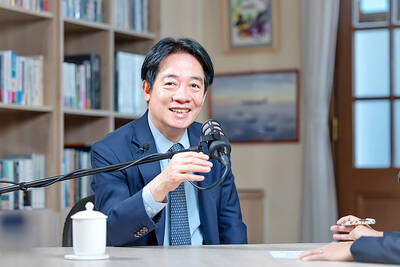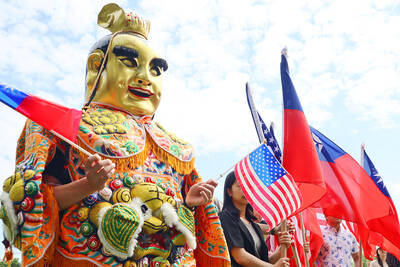It’s been a good year for touch screens.
The launch of the first iPhone model a year ago boosted interest in the technology tremendously and the updated model made available last Friday will likely stoke enthusiasm further. Now touch-screen manufacturers are going flat out, and more devices will soon be controlled by the tip of your finger.
“After the iPhone came out, a lot of mobile-phone companies said: ‘Oh, I can make that kind of touch-screen mobile phone, too,”’ said Jennifer Colegrove, an analyst at iSuppli Corp.
In the US, Sprint Nextel Corp just introduced a touch-screen phone, the Samsung Instinct, that’s very reminiscent of the iPhone.
Verizon Wireless this year introduced its first two phones that use touch screens as their main interface. Research In Motion Ltd is believed to be making a touch-screen version of the BlackBerry. Sony Ericsson is bringing out its first touch-screen model in a few months.
Jon Mulder, product marketing manager for Sony Ericsson’s US arm, said touch screens have become a “hygiene factor” — a must-have for phones that want to compete in the high end of the US market.
Colegrove projects that 341 million touch screens would be shipped worldwide this year, up from 218 million last year and 81 million in 2006.
In the first half of last year, before Apple Inc’s iPhone launch, a big maker of touch sensors for portable electronics would make perhaps 1 million units per month, Colegrove said.
“Then in the second half of 2007, suddenly they received huge orders, so they ramped up their production to maybe 3 or 4 million units per month,” she said.
Apart from the iPhone, demand for touch screens is driven by new phones in Asia that allow the user to write Chinese or Japanese characters on the screen, usually with the aid of a stylus. That’s much easier than entering those characters with a keypad, Colegrove said.
Most touch sensors are made in Japan, Taiwan and China by companies that are relatively unknown in the US, like Nissha Printing Co, Wintek Corp (勝華) and Truly Semiconductors Ltd.
Balda AG of Germany supplied the touch sensor for the first iPhone through a joint venture with a Chinese company.
In the US, major players in the touch field are 3M Co, though it mainly supplies larger screens for ATMs and monitors rather than portable electronics, and Synaptics Inc, which supplies components for Apple. Others, like Cypress Semiconductor Corp, make the chips that control the sensors.
Synaptics has a growing business supplying touch sensors for cellphones as well. The firm uses a particular type of touch sensor known as “projected capacitive.” Before the iPhone came along, Synaptics was struggling to convince manufacturers that the technology was better than the cheaper “resistive” screens.
“The technology was there to use years before the iPhone,” said Andrew Hsu, Synaptics’ touch-screen expert.
Capacitive sensors are more durable, interfere less with the screen’s image and can sense the touch of more than one finger at a time — allowing for the iPhone’s signature “multitouch” ability.
They cost about US$20 for an iPhone-size sensor, compared with about US$5 for a resistive screen.
Frustrated with the lack of interest, Synaptics put together its own concept phone — the Onyx — in 2006 to demonstrate the capabilities of the touch screen, including multitouch input. LG of Korea then used Synaptics’ touch sensor in its Prada phone, which came out some months before the iPhone. But it was Apple that broke the barriers, Hsu said.
“The best showcase of this technology has been the introduction of a production model that works very well,” he said.
Colegrove expects projected capacitive sensors to be among the fastest-growing technologies, with more than 35 million units shipped this year, mainly for the iPhone and iPod Touch. That’s up from 10 million units last year and only a handful in 2006. But the more conventional resistive type will continue to make up most of the volume, especially since they’re better suited to stylus input for the Asian market.
The touch-screen craze is spreading beyond cellphones as well.
Microsoft Corp chairman Bill Gates has said touch sensors and speech recognition are a focus of the company’s development efforts.

Nvidia Corp yesterday unveiled its new high-speed interconnect technology, NVLink Fusion, with Taiwanese application-specific IC (ASIC) designers Alchip Technologies Ltd (世芯) and MediaTek Inc (聯發科) among the first to adopt the technology to help build semi-custom artificial intelligence (AI) infrastructure for hyperscalers. Nvidia has opened its technology to outside users, as hyperscalers and cloud service providers are building their own cost-effective AI chips, or accelerators, used in AI servers by leveraging ASIC firms’ designing capabilities to reduce their dependence on Nvidia. Previously, NVLink technology was only available for Nvidia’s own AI platform. “NVLink Fusion opens Nvidia’s AI platform and rich ecosystem for

‘WORLD’S LOSS’: Taiwan’s exclusion robs the world of the benefits it could get from one of the foremost practitioners of disease prevention and public health, Minister Chiu said Taiwan should be allowed to join the World Health Assembly (WHA) as an irreplaceable contributor to global health and disease prevention efforts, Minister of Foreign Affairs Lin Chia-lung (林佳龍) said yesterday. He made the comment at a news conference in Taipei, hours before a Taiwanese delegation was to depart for Geneva, Switzerland, seeking to meet with foreign representatives for a bilateral meeting on the sidelines of the WHA, the WHO’s annual decisionmaking meeting, which would be held from Monday next week to May 27. As of yesterday, Taiwan had yet to receive an invitation. Taiwan has much to offer to the international community’s

CAUSE AND EFFECT: China’s policies prompted the US to increase its presence in the Indo-Pacific, and Beijing should consider if this outcome is in its best interests, Lai said China has been escalating its military and political pressure on Taiwan for many years, but should reflect on this strategy and think about what is really in its best interest, President William Lai (賴清德) said. Lai made the remark in a YouTube interview with Mindi World News that was broadcast on Saturday, ahead of the first anniversary of his presidential inauguration tomorrow. The US has clearly stated that China is its biggest challenge and threat, with US President Donald Trump and US Secretary of Defense Pete Hegseth repeatedly saying that the US should increase its forces in the Indo-Pacific region

ALL TOGETHER: Only by including Taiwan can the WHA fully exemplify its commitment to ‘One World for Health,’ the representative offices of eight nations in Taiwan said The representative offices in Taiwan of eight nations yesterday issued a joint statement reiterating their support for Taiwan’s meaningful engagement with the WHO and for Taipei’s participation as an observer at the World Health Assembly (WHA). The joint statement came as Taiwan has not received an invitation to this year’s WHA, which started yesterday and runs until Tuesday next week. This year’s meeting of the decisionmaking body of the WHO in Geneva, Switzerland, would be the ninth consecutive year Taiwan has been excluded. The eight offices, which reaffirmed their support for Taiwan, are the British Office Taipei, the Australian Office Taipei, the